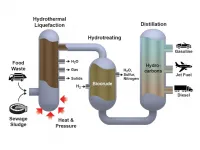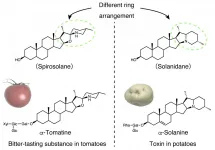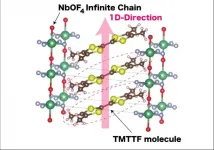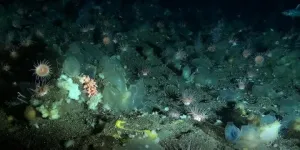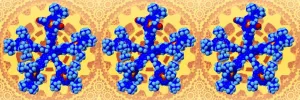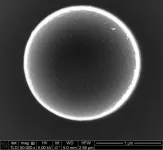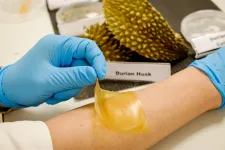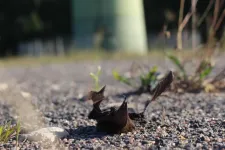(Press-News.org) RICHLAND, WASH.--A large-scale demonstration converting biocrude to renewable diesel fuel has passed a significant test, operating for more than 2,000 hours continuously without losing effectiveness. Scientists and engineers led by the U.S. Department of Energy's Pacific Northwest National Laboratory conducted the research to show that the process is robust enough to handle many kinds of raw material without failing.
"The biocrude oil came from many different sources, including wastewater sludge from Detroit, and food waste collected from prison and an army base," said John Holladay, a PNNL scientist and co-director of the joint Bioproducts Institute, a collaboration between PNNL and Washington State University. "The research showed that essentially any biocrude, regardless of wet-waste sources, could be used in the process and the catalyst remained robust during the entire run. While this is just a first step in demonstrating robustness, it is an important step."
The milestone was first described at a virtual conference organized by NextGenRoadFuels, a European consortium funded by the EU Framework Programme for Research and Innovation. It addresses the need to convert biocrude, a mixture of carbon-based polymers, into biofuels. In the near term, most expect that these biofuels will be further refined and then mixed with petroleum-based fuels used to power vehicles.
"For the industry to consider investing in biofuel, we need these kinds of demonstrations that show durability and flexibility of the process," said Michael Thorson, a PNNL engineer and project manager.
Biocrude to biofuel, the crucial conversion
Just as crude oil from petroleum sources must be refined to be used in vehicles, biocrude needs to be refined into biofuel. This step provides the crucial "last mile" in a multi-step process that starts with renewables such as crop residues, food residues, forestry byproducts, algae, or sewage sludge. For the most recent demonstration, the biocrude came from a variety of sources including converted food waste salvaged from Joint Base Lewis-McChord, located near Tacoma, Wash., and Coyote Ridge Corrections Center, located in Connell, Wash. The initial step in the process, called hydrothermal liquefaction, is being actively pursued in a number of demonstration projects by teams of PNNL scientists and engineers.
The "last mile" demonstration project took place at the Bioproducts, Sciences, and Engineering Laboratory on the Richland, Wash. campus of Washington State University Tri-Cities. For 83 days, reactor technician Miki Santosa and supervisor Senthil Subramaniam fed a constant flow of biocrude into carefully honed and highly controlled reactor conditions. The hydrotreating process introduces hydrogen into a catalytic process that removes sulfur and nitrogen contaminants found in biocrude, producing a combustible end-product of long-chain alkanes, the desirable fuel used in vehicle engines. Chemist Marie Swita analyzed the biofuel product to ensure it met standards that would make it vehicle-ready.
Diverting carbon to new uses
"Processing food and sewage waste streams to extract useful fuel serves several purposes," said Thorson. Food waste contains carbon. When sent to a landfill, that food waste gets broken down by bacteria that emit methane gas, a potent greenhouse gas and contributor to climate change. Diverting that carbon to another use could reduce the use of petroleum-based fuels and have the added benefit of reducing methane emissions.
The purpose of this project was to show that the commercially available catalyst could stand up to the thousands of hours of continuous processing that would be necessary to make biofuels a realistic contributor to reducing the world's carbon footprint. But Thorson pointed out that it also showed that the biofuel product produced was of high quality, regardless of the source of biocrude?an important factor for the industry, which would likely be processing biocrude from a variety of regional sources.
Indeed, knowing that transporting biocrude to a treatment facility could be costly, modelers are looking at areas where rural and urban waste could be gathered from various sources in local hubs. For example, they are assessing the resources available within a 50-mile radius of Detroit, Mich. There, the sources of potential biocrude feedstock could include food waste, sewage sludge and cooking oil waste. In areas where food waste could be collected and diverted from landfills, much as recycling is currently collected, a processing plant could be up to 10 times larger than in rural areas and provide significant progress toward cost and emission-reduction targets for biofuels.
Commercial biofuels on the horizon
Milestones such as hours of continuous operation are being closely watched by investor groups in the U.S. and Europe, which has set aggressive goals, including being the first climate-neutral continent by 2050 and achieving a 55% reduction in greenhouse gas emissions by 2030. "A number of demonstration projects across Europe aim to commercialize this process in the next few years," Holladay said.
The next steps for the research team include gathering more sources of biocrude from various waste streams and analyzing the biofuel output for quality. In a new collaboration, PNNL will partner with a commercial waste management company to evaluate waste from many sources. Ultimately, the project will result in a database of findings from various manures and sludges, which could help decide how facilities can scale up economically.
"Since at least three-quarters of the input and output of this process consists of water, the ultimate success of any industrial scale-up will need to include a plan for dealing with wastewater," said Thorson. This too is an active area of research, with many viable options available in many locations for wastewater treatment facilities.
INFORMATION:
DOE's Bioenergy Technologies Office has been instrumental in supporting this project, as well as the full range of technologies needed to make biofuels feasible.
Pacific Northwest National Laboratory draws on its distinguishing strengths in chemistry, Earth sciences, biology and data science to advance scientific knowledge and address challenges in sustainable energy and national security. Founded in 1965, PNNL is operated by Battelle for the U.S. Department of Energy's Office of Science, which is the single largest supporter of basic research in the physical sciences in the United States. DOE's Office of Science is working to address some of the most pressing challenges of our time. For more information, visit PNNL's News Center. Follow us on Twitter, Facebook, LinkedIn and Instagram.
LA JOLLA--(March 25, 2021) The brush of an insect's wing is enough to trigger a Venus flytrap to snap shut, but the biology of how these plants sense and respond to touch is still poorly understood, especially at the molecular level. Now, a new study by Salk and Scripps Research scientists identifies what appears to be a key protein involved in touch sensitivity for flytraps and other carnivorous plants.
The findings, published March 16, 2021, in the journal eLife, help explain a critical process that has long puzzled botanists. This could help scientists better understand how plants of all kinds sense and respond to mechanical stimulation, and could also have a potential application in medical therapies that mechanically stimulate human cells such as neurons.
"We know that plants ...
A multi-institutional collaboration has revealed that α-solanine, a toxic compound found in potato plants, is a divergent of the bitter-tasting α-tomatine, which is found in tomato plants. The research group included Associate Professor MIZUTANI Masaharu and Researcher AKIYAMA Ryota et al. of Kobe University's Graduate School of Agricultural Science, Assistant Professor WATANABE Bunta of Kyoto University's Institute for Chemical Research, Senior Research Scientist UMEMOTO Naoyuki of the RIKEN Center for Sustainable Resource Science, and Professor MURANAKA Toshiya of Osaka University's Graduate School of Engineering.
It ...
Salts are far more complicated than the food seasoning - they can even act as electrical conductors, shuttling current through systems. Extremely well studied and understood, the electrical properties of salts were first theorized in 1834. Now, nearly 200 years later, researchers based in Japan have uncovered a new kind of salt.
The results were published on March 17 in Inorganic Chemistry, a journal of the American Chemical Society.
The researchers were specifically investigating how one-dimensional versions of three-dimensional substances exhibit unique physical phenomena and functionality in a process called the ...
CORVALLIS, Ore. - A novel analysis of encounters between albatross and commercial fishing vessels across the North Pacific Ocean is giving researchers important new understanding about seabird-vessel interactions that could help reduce harmful encounters.
The new research method, which combines location data from GPS-tagged albatross and commercial fishing vessels, allows researchers to accurately identify bird-vessel encounters and better understand bird behavior, environmental conditions and the characteristics that influence these encounters.
"It is hard to conceptualize how often birds ...
For the first time, researchers from the SponGES project collected year-round video footage and hydrodynamic data from the mysterious world of a deep-sea sponge ground in the Arctic. Deep-sea sponge grounds are often compared to the rich ecosystems of coral reefs and form true oases. In a world where all light has disappeared and without obvious food sources, they provide a habitat for other invertebrates and a refuge for fish in the otherwise barren landscape. It is still puzzling how these biodiversity hotspots survive in this extreme environment as deep as 1500 metres below the water surface. With over 700 hundred ...
Ikoma, Japan - Gear trains have been used for centuries to translate changes in gear rotational speed into changes in rotational force. Cars, drills, and basically anything that has spinning parts use them. Molecular-scale gears are a much more recent invention that could use light or a chemical stimulus to initiate gear rotation. Researchers at Nara Institute of Science and Technology (NAIST), Japan, in partnership with research teams at University Paul Sabatier, France, report in a new study published in Chemical Science a means to visualize snapshots of an ultrasmall ...
People who are physically active on a regular basis recover better after surgery for colorectal cancer. However, starting to exercise only after the diagnosis is a fact had no effect on recovery, a University of Gothenburg thesis shows.
In working on his thesis, Aron Onerup, who obtained his doctorate in surgery at the University's Sahlgrenska Academy and is now a specialist doctor at Sahlgrenska University Hospital, carried out an observational study of 115 patients diagnosed with colorectal cancer.
The participants who had been physically inactive proved, three weeks after their surgery, to be at higher risk of not feeling that they ...
Microswimmers are artificial, self-propelled, microscopic particles. They are capable of directional motion in a solution. The Molecular Nanophotonics Group at Leipzig University has developed special particles that are smaller than one-thirtieth of the diameter of a hair. They can change their direction of motion by heating tiny gold particles on their surface and converting this energy into motion. "However, these miniaturised machines cannot take in and learn information like their living counterparts. To achieve this, we control the microswimmers externally so that they learn to navigate in a virtual environment through what is known as reinforcement learning," said Cichos.
With the help of virtual rewards, the microswimmers find their way through the liquid ...
Food scientists from Nanyang Technological University, Singapore (NTU Singapore) have made an antibacterial gel bandage using the discarded husks of the popular tropical fruit, durian.
Known as the "King of Fruits" in Southeast Asia, the durian has a thick husk with spiky thorns which is discarded, while the sweet flesh surrounding the seeds on the inside is considered a delicacy.
By extracting high-quality cellulose from the durian husks and combining it with glycerol - a waste by-product from the biodiesel and soap industry - NTU scientists created a soft gel, similar to silicon sheets, which can be cut into bandages of various shapes and sizes.
They then added the organic molecules produced from baker's yeast known as natural yeast phenolics, making the bandage deadly ...
In order to assess the risk of bats dying at wind turbines, it is common practice to record the acoustic activity of bats within the operating range of the rotor blades. For this purpose, ultrasonic detectors are attached to the nacelles of the mast top. In a recent analysis, a team of scientists led by the Leibniz Institute for Zoo and Wildlife Research (Leibniz-IZW) concludes that the effectiveness of this acoustic monitoring is insufficient to reliably predict mortality risk, especially for bats at large turbines. They therefore recommend installing supplementary ultrasonic detectors at other locations on the wind turbines and developing additional techniques such as radar and thermal imaging cameras for monitoring. The results of their analysis are published in ...
